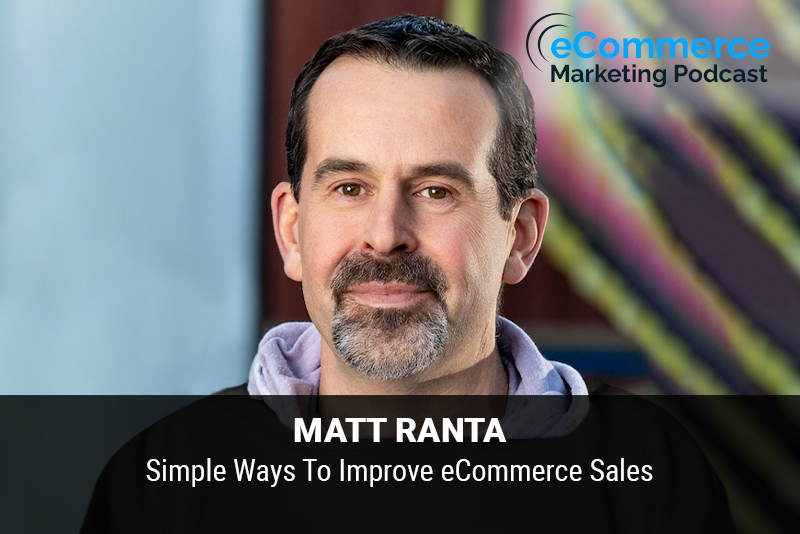
The eCommerce Marketing Podcast walks you through everything that goes into ecommerce marketing — from inbound marketing to paid advertising to conversions. Learn the strategies top marketing experts use to grow their businesses.
Matt Ranta is a partner and head of Digital & eCommerce with Nimble Gravity which is a consultancy specializing in data science, digital strategy, e-commerce, near-shore engineering teams, analytics, and organizational strategy. They work with companies ranging in size from startup to those with billions in revenue, and across varied industries such as endangered species protection, healthcare, DTC clothing, and more.
In this episode, you will learn
The most common mistakes that e-commerce companies make when it comes to marketing and overall performance
Cost-effective and easy-to-implement strategies that e-commerce businesses can use to optimize their website for conversions and user experience
Key performance indicators (KPIs) that e-commerce companies should monitor to measure the success of their marketing efforts
How can e-commerce companies effectively leverage social media to improve their performance and reach a larger audience
Successful case studies where e-commerce companies have made simple changes to their marketing strategy that resulted in significant improvements in performance
For show transcript and past guests, please visit https://www.ecommercemarketingpodcast.com
Or on YouTube at:
https://www.youtube.com/channel/UC3PgT0NOGzpdPGQtBK0XLIQ
Follow Arlen:
Twitter: https://twitter.com/askarlen
Facebook: https://www.facebook.com/arlen.robinson.7
Instagram: https://www.instagram.com/arlenyohance/
LinkedIn: https://www.linkedin.com/in/arlenrobinson/
Past guests on the ecommerce marketing podcast include Neil Patel, Nemo Chu, Luke Lintz, Luke Carthy, Amber Armstrong, Kris Ruby and many more.
Thanks for listening. Be sure to subscribe and leave a review.

Title: Simple Strategies to Improve E-Commerce Performance with Matt Ranta
Guest: Matt Ranta, Partner and Head of Digital & eCommerce at Nimble Gravity
Host: Arlen Robinson
In this episode of the eCommerce Marketing Podcast, Arlen Robinson sits down with Matt Ranta, Partner and Head of Digital & eCommerce at Nimble Gravity. Matt shares his vast experience in the e-commerce space and discusses simple yet effective strategies that e-commerce businesses can implement to improve their overall performance.
Key Takeaways:
- [00:06:26] Common Mistakes in E-Commerce:
- Make your site faster: Improve site speed to enhance SEO ranking, customer experience, and overall performance.
- [00:07:57] Surface Your Content:
- Ensure that content is easily accessible and not buried deep within the site. Use pagination, interlinking, and breadcrumbs.
- [00:09:54] Improve Your Email Marketing:
- Proofread emails, use tools like Email on Acid to check for consistency across different clients, and ensure proper grammar and templates.
- [00:13:23] Leveraging Big E-Commerce Practices:
- Take inspiration from major e-commerce sites like Amazon and Walmart, particularly in user experience design (e.g., prominent search bars).
- [00:13:06] Utilizing Free Tools:
- Use tools like Microsoft Clarity for heat mapping, rage click analysis, and qualitative analytics to understand user behavior.
- [00:16:49] Key Performance Indicators:
- Monitor return on ad spend, bounce rate, conversion rates, operational metrics like same-day shipments, and re-engagement rates.
- [00:23:03] Effective Use of Social Media:
- Don’t assume your customers aren’t on specific platforms. Use internal management or agencies to handle social media, schedule posts, and explore new trends like live streaming shopping.
- [00:27:21] Case Study – Simple Changes:
- A client in flower sales improved their performance by changing product imagery, resulting in a significant increase in clicks and reduction in order refusals.
Guest Info:
- Matt Ranta
- Partner, Head Of Practice – Digital & E-commerce at Nimble Gravity
- Website: Nimble Gravity
- LinkedIn: Matt Ranta











